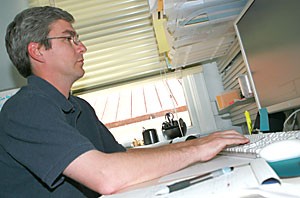The cassava, a root similar to a potato that is grown mainly in South America and Africa, has been chosen to have its genome sequenced by researchers, including a UA scientist, for humanitarian and energy purposes by the U.S. Department of Energy Joint Genome Institute.
The UA, which played a major role in sequencing the genome of rice, is providing one of the multi-institutional team’s main researchers, Steven Rounsley, associate research professor for BIO5 Institute and the Department of Plant Sciences, with a place to study the cassava genome in the newly opened BIO5 building.
“”The cassava is a very important crop for subsistence farmers in Africa, and to obtain more information that farmers can use will help them build better crops for the poorest people,”” said Vicki Chandler, director of the BIO5 Institute.
The cassava, which is second to rice in the developing world as a main source of food, has a unique potential for conversion into ethanol because of its high percentage of starch, Rounsley said.
Interest in the cassava from the science community is still small, Rounsley said, but since the U.S. Department of Energy’s Bioenergy Initiative, the government has taken interest in bioenergy and turning things like corn or other starchy material into ethanol fuel.
“”The cassava is not generally an interesting crop for the scientific community, but the recent energy proposal kicked it all together and there is a reality for a potential energy use,”” Rounsley said.
Despite the interests in ethanol fuel, the future of converting the starch in the cassava into ethanol is still unsure, and it will be a long-term research process before they come up with future uses such as alternative fuel, Rounsley said.
But for billions of people in developing countries, the cassava is part of a daily diet. From a humanitarian perspective, the cassava genome sequencing project will benefit those people who eat it on a daily basis.
“”The problem with the cassava is that it’s so full of starch. There is very little in nutrition,”” Rounsley said. “”Protein is missing and there is a cyanide compound in raw cassava that makes it poisonous to eat.””
In sequencing the cassava genome, there are hopes to make it more nutritious and safer to consume, and to protect the root from disease.
“”Plant diseases can wipe out entire crops, and if this happens to a farmer in Africa he not only loses his source of income, but also his food source and the food source of the community,”” Rounsley said.
Africa and South America are one of the largest producers of cassava because the root can survive draught conditions and can grow in poor soil, Rounsley said.
“”The cassava is a major crop in Latin America, and the cassava is not a trivial crop, and the genome sequence of the cassava will be helpful in identifying ways to improve the crop,”” said Robert Leonard, head of the plant sciences department.
The sequencing project is still in the pilot phase, said Rounsley, meaning the DOE is still evaluating the data to pick the next step.
After the DOE has completed evaluating the data, the information will be passed on to researchers such as Rounsley to interpret and evaluate the data and find a meaning.
“”Sequencing a genome is like reorganizing a textbook where the chapters, words and sentences are all mixed up,”” Rounsley said. “”I try to define a beginning and end to come to a meaning.””
It takes about a year to generate a DNA sequence, and the resulting genome can have a DNA sequence 800 million letters long, which is the same amount as a grain of rice, Rounsley said.
“”In terms of getting useful information to breeders, farmers and scientists, we will try to get it to them as quickly as possible, but it may take one to three years,”” Rounsley said.
In January, the UA was ranked No. 1 in agricultural sciences and No. 4 in botany and plant biology, according to the Faculty Scholarly Productivity Index, which is based on faculty scholarly activity.
“”The UA is very strong in plant genetics and genomics,”” Chandler said. “”Steve is a really good addition and builds strength in our plant genomics research.””









